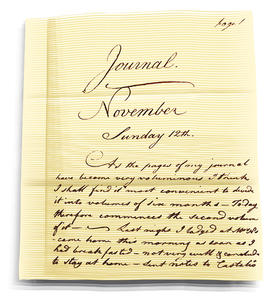
The decisive event of James Gibson 1787’s young life happened on March 14, 1785, when Gibson, then a sophomore at Princeton College, met a young man named John Mifflin at the theater. Mifflin was wading through the crowd, looking for a seat; Gibson offered him one. “His gentle manners [and] modest politeness,” Mifflin later wrote, “made me feel an immediate attachment to him — when the lecture was over we returned home together — [and] at parting made an appointment to meet at the next lecture.”
This was the start of an intense and yearslong companionship between the two young men. The relationship was striking in part because they conducted it through diaries. Because Gibson spent his days in Princeton and Mifflin in Philadelphia, they kept each other close by writing diaries meant for each other’s eyes. Sometimes they mailed each other pages; the rest they saved to share during visits.
Mifflin, who was in his 20s, was stylish and worldly, a rare Quaker dandy. Gibson was shy and shabby-genteel, charged with using college to renew his family’s fortunes after his father’s death. He wrote often of his loneliness: “After dinner … walked about — tumbled over different books — dull dismal weather still continues … such days lag heavily without a friend.”
The diaries don’t specify, in modern terms, what they meant to each other. Gibson calls Mifflin Leander, a reference to a lover from Greek mythology. Mifflin, in turn, calls Gibson Lorenzo, which the historian Caleb Crain suggests may refer to a 1742 poem titled “Night Thoughts.”
They kept the diaries going even when they were together. During one of Mifflin’s visits to Princeton, Gibson wrote of him, “after recitation [I] went to Leander — he gave me a hair ribbon and I promised to sleep with him tonight.” And they found other ways to be together when apart; Mifflin mentions a souvenir that Gibson gave him, “a to[ken] of friendship,” which, Mifflin writes, he treats as a tangible proof of their bond, “putting it to my lips.”
At the time, bed-sharing was normal for male friends. Their acquaintance was no secret; Mifflin often called on Gibson’s mother to chat about her son, and when Mifflin visited Princeton, Gibson would have had to ask the University for approval to let Mifflin sleep over. So, if you like, you can think of them as just good friends. When Mifflin visited Gibson’s room at Princeton, they tacked Gibson’s gown over the window to keep other students from seeing in. While taking a jaunt with Gibson across New Jersey, Mifflin mentioned, in his diary, that he got a bruise: “In the evening as I was wrestling with Lorenzo I fell on the side of my head [and] hurt myself a little.”
In 1786, Mifflin, who was in a low emotional spell, decided to test his friend’s loyalty. The next time he visited Princeton, he waited until Gibson was in class, then wrote what we might call a break-up letter. “Wrote a long letter to Lorenzo, with a plan which my heart did not dictate — a trial of his affection — [and] almost wept at the conclusion
of it.” He left it where Gibson would find it and hid to see what would happen. “[T]here was something mild [and] uncertain when he looked at the letter, he seemed to open it hesitatingly [and] his eyes flew precipitately over every page [and] then to the cover before he began to read — he had perused but a few lines when his countenance fell … .”
Gibson fled, and Mifflin ran after him. They met at the gate in front of Nassau Hall. Mifflin explained that the whole thing was “only a trial what dependance I might have on his friendship [and] affection — the dear fellow seemed hurt at the experiment, but gave me the fullest assurances of his attachment — [and] I felt mine doubly renewed to him by the consciousness he testified of his own sincerity.”
In the end, they had to join the stream of history, as we all do; the space of possibility that their youth afforded them ended, and the diaries stopped. Gibson became a lawyer, passing the bar in 1791. Both men married; one had children. But for a time, they wrote each other into their lives. They made a path, as a poet once said, that would admit no limits on the human capacity to love.
Today, their diaries reside in the archives of the Historical Society of Pennsylvania. The diaries are bound together.











No responses yet